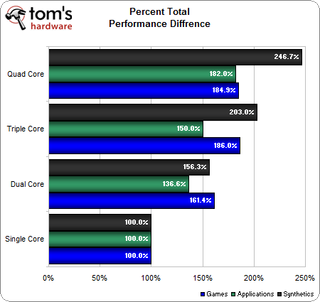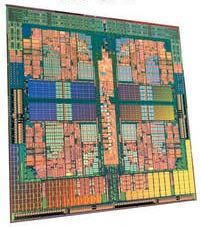
When you purchase through links on our site, we may earn an affiliate commission. Here’s how it works.
Page 11 of 11:Time to draw some conclusions. Because we have a lot of data to digest, let's simplify it by averaging the performance on a graph:

First, we see that the synthetic benchmarks are overly optimistic as to what multiple cores can accomplish compared to the average real-world scenario. The synthetic performance progression between a single core and multiple cores looks like an almost linear progression of 50% performance increases with each new CPU core.
The average application gains show us a much more realistic progression, with about a 35% speed increase with the second CPU core, a 15% jump with the third, and another 32% jump with the fourth. It's strange that the third CPU core seems to provide half the advantage of adding a fourth CPU core to the mix.
And when considering applications, we must look at individual software titles instead of just the big picture. Indeed, the audio-encoding software we tested seems to offer no multi-core optimizations of which to speak. However, video encoding software conversely offers massive benefits with more CPU cores and depends somewhat on the video encoder utilized. In the case of 3D rendering software, 3ds Max usually has highly optimized multi-core performance improvements, while 2D photo editors like Photoshop seem to have none at all. AVG anti-virus demonstrates massive performance increases with multiple cores, while compression utilities seem to sport little to no multi-threading benefits.
As far as games go, we see a huge 60% performance jump from going single-core to dual-core, and a further 25% leap from dual- to triple-core. Quad cores offer no benefits in the sampling of games we tested. While more games might change the landscape a little, we think the triple-core Phenom II X3s are looking good as a low-cost gaming option. It's also important to note here that as you start shifting to higher resolutions and adding visual detail, the picture gets a lot murkier as graphics muscle becomes the prevalent determinant of frame rates.

After all is said and done, we can come to a few general conclusions based on this data. We don't think you have to be a power-user to enjoy the benefits of a multi-core CPU. This is in stark contrast to the situation four years ago. So, while these gains might not be overwhelming at first glance, it's impressive to note how much thread-level optimization has gone on in the last few years, particularly in the applications identified as most receptive to acceleration through parallelism. In fact, we'll go as far as to say that there is relatively little reason to consider a single-core CPU (if you can find one), except for power-saving applications.
There are a few applications for which users should invest in as many CPU cores as possible, which include video encoding, 3D rendering, and optimized productivity titles, such as AVG's virus-scanning software. The lesson for the gamer is that long gone are the days when a single-core CPU paired with a powerful graphics solution would be "good enough."
Get Tom's Hardware's best news and in-depth reviews, straight to your inbox.
By submitting your information you agree to the Terms & Conditions and Privacy Policy and are aged 16 or over.
Current page: Performance Analysis And Conclusion